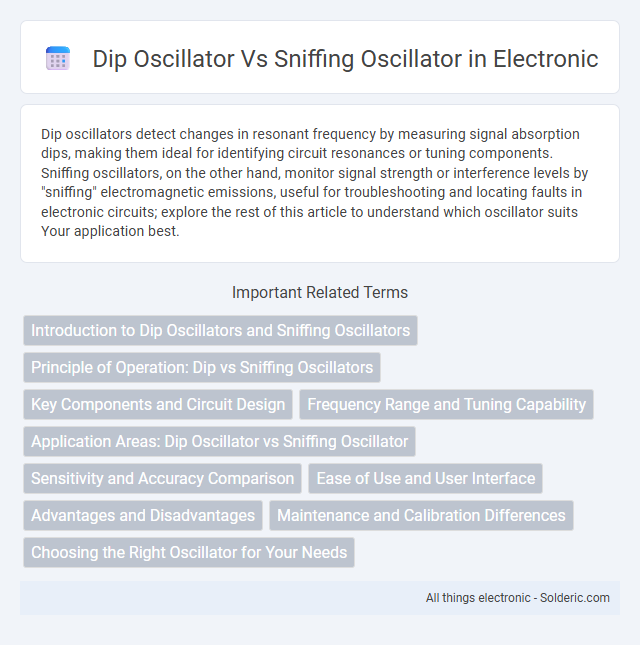Dip oscillators detect changes in resonant frequency by measuring signal absorption dips, making them ideal for identifying circuit resonances or tuning components. Sniffing oscillators, on the other hand, monitor signal strength or interference levels by "sniffing" electromagnetic emissions, useful for troubleshooting and locating faults in electronic circuits; explore the rest of this article to understand which oscillator suits Your application best.
Comparison Table
| Feature | DIP Oscillator | Sniffing Oscillator |
|---|---|---|
| Function | Detects changes in resonant frequency by observing dips in oscillator output | Measures oscillator frequency shifts by "sniffing" or sampling signal variations externally |
| Measurement Method | Direct frequency dip detection within oscillator circuit | Indirect frequency monitoring via external probe or sensor |
| Use Case | Used for precise sensing in LC circuits, RF filters, and material property testing | Applied in monitoring oscillator frequency changes without circuit interference |
| Sensitivity | High sensitivity to frequency changes due to direct circuit integration | Moderate sensitivity influenced by probe quality and environment |
| Complexity | Moderate complexity; requires integrated oscillator design | Lower complexity; uses external sampling equipment |
| Interference | Minimal external interference; internal measurement | Potential for signal distortion from external probing |
| Typical Applications | Material characterization, RF tuning, dielectric measurements | Non-invasive frequency monitoring, signal diagnostics |
Introduction to Dip Oscillators and Sniffing Oscillators
Dip oscillators detect changes in resonant frequency by monitoring the amplitude dips in a circuit, commonly used for identifying resonator characteristics and testing impedance. Sniffing oscillators, in contrast, detect oscillations in nearby circuits by sensing electromagnetic emissions, often employed in troubleshooting and leakage detection. Both tools play critical roles in electronic diagnostics, with dip oscillators focusing on resonant properties and sniffing oscillators targeting signal leakage and interference.
Principle of Operation: Dip vs Sniffing Oscillators
Dip oscillators operate by detecting a reduction in amplitude or a "dip" when the oscillator frequency matches the resonant frequency of a nearby circuit, indicating energy absorption at that frequency. Sniffing oscillators function by inductively coupling to a circuit and sensing the signal strength or frequency without causing significant load or disturbance. Understanding these principles helps you select the appropriate oscillator type for non-intrusive frequency measurement or resonance detection applications.
Key Components and Circuit Design
Dip oscillators use a resonant circuit with a variable capacitor or inductor to detect frequency changes, crucial for tuning and component testing. Sniffing oscillators feature a high-impedance probe and amplifier stage designed to trace signals in circuits without loading effects. Understanding these key components helps optimize your circuit design for accurate frequency measurement and signal detection.
Frequency Range and Tuning Capability
Dip oscillators typically operate over a narrow frequency range, often in the low MHz to hundreds of MHz, with limited tuning capability suited for detecting resonant dips in circuits or components. Sniffing oscillators offer broader frequency coverage, from kHz to GHz, with enhanced tuning precision, enabling you to identify and analyze varying signal frequencies more effectively. The choice between these oscillators depends on the required frequency range and the flexibility needed for tuning to specific signals in your application.
Application Areas: Dip Oscillator vs Sniffing Oscillator
Dip oscillators are primarily used for detecting resonance frequency changes in RF circuits, antenna tuning, and identifying faults in inductors and capacitors. Sniffing oscillators find applications in troubleshooting electronic devices by tracing signal paths, detecting interference sources, and locating circuit faults through signal injection. Their distinct roles cater to precise fault diagnosis and component characterization in radio frequency and electronic maintenance.
Sensitivity and Accuracy Comparison
Dip oscillators typically offer higher sensitivity due to their ability to detect minor changes in resonant frequency by monitoring signal dips, making them ideal for pinpointing small variations. Sniffing oscillators excel in accuracy when measuring the presence and exact frequency of signals within a broad spectrum, using precise amplitude and frequency detection techniques. Sensitivity in dip oscillators is generally superior for identifying subtle resonant frequency shifts, whereas sniffing oscillators prioritize frequency accuracy and signal identification over minimal sensitivity changes.
Ease of Use and User Interface
The dip oscillator features a straightforward user interface with simple controls, making it highly accessible for beginners and quick measurements. In contrast, sniffing oscillators often incorporate more advanced features and adjustable parameters, requiring a steeper learning curve but providing greater precision for experienced users. Ease of use for the dip oscillator prioritizes rapid detection, while sniffing oscillators emphasize detailed signal analysis with more complex interfaces.
Advantages and Disadvantages
Dip oscillators offer precise frequency measurement by detecting a drop in amplitude when coupled with a resonant circuit, making them ideal for identifying resonance points without direct circuit interference. Their limitation lies in slower response times and potential complexity in tuning compared to sniffing oscillators. Sniffing oscillators enable rapid detection of RF signals by injecting test signals and observing circuit behavior, providing faster troubleshooting but sometimes causing circuit loading and less accuracy in resonance identification.
Maintenance and Calibration Differences
DIP oscillators require less frequent calibration due to their self-contained design and stable frequency output, reducing overall maintenance efforts. Sniffing oscillators demand regular calibration to maintain accuracy, as their detected signals can drift over time from environmental factors and component aging. Maintenance of DIP oscillators involves simple battery checks and occasional verification, while sniffing oscillators necessitate more rigorous periodic testing and component adjustments to ensure precise operation.
Choosing the Right Oscillator for Your Needs
Selecting the right oscillator depends on your specific application and measurement requirements, where a dip oscillator excels in detecting resonant frequency dips in circuits with high accuracy. Sniffing oscillators are more suitable for tracing and diagnosing high-frequency signals along circuit paths, offering quick and localized signal detection. Your choice should prioritize whether frequency identification precision or signal tracing convenience is essential for optimal performance.
dip oscillator vs sniffing oscillator Infographic

 solderic.com
solderic.com